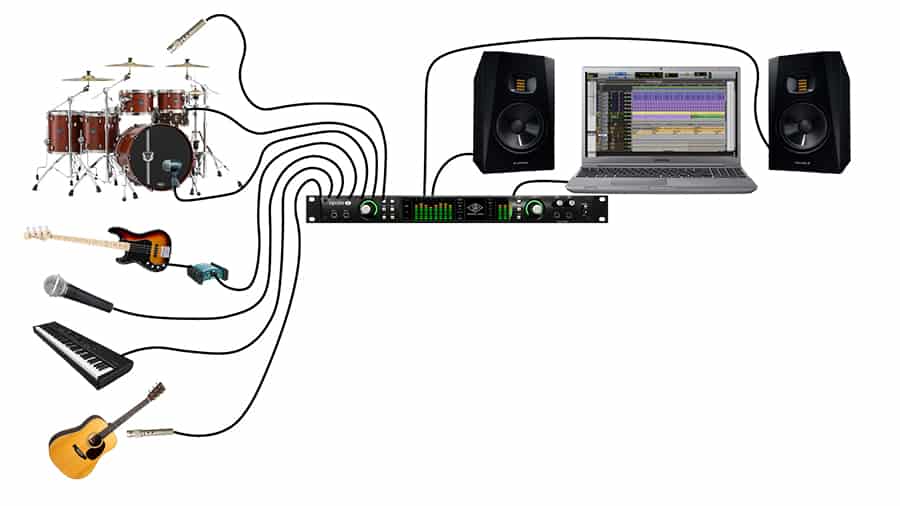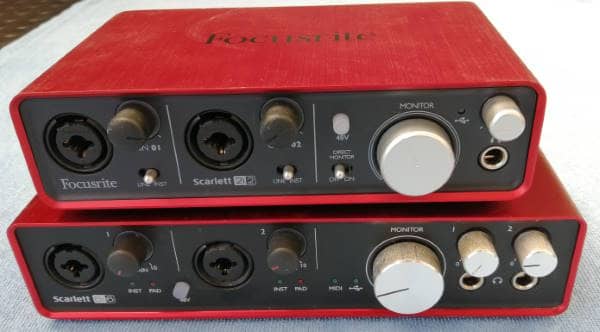How many inputs do you need for an audio interface? The answer depends on your needs and projects.
In the meantime, don't forget to unlock a world of unlimited sound with Amazon Music Unlimited, where over 100 million songs wait at your fingertips. Whether you're working, relaxing, or fueling your creativity, the right track is always just one tap away. Elevate every moment with music that moves you.
Some might need only a few, while others require many. Selecting the right number of inputs for your audio interface is crucial. It ensures your setup meets your recording requirements. Whether you’re a solo artist, a podcaster, or part of a band, the number of inputs can impact your workflow.
Too few inputs might limit your creative process. Too many could mean unnecessary expense. Understanding your current and future needs will guide you in making the best choice. This blog will explore different scenarios and help you determine the perfect number of inputs for your audio interface. Let’s dive in and find the right balance for your audio setup.
Introduction To Audio Interfaces
Audio interfaces are essential tools for musicians, podcasters, and audio engineers. They help convert analog signals into digital ones, making recording and editing audio much easier. Whether you are setting up a home studio or enhancing your podcasting setup, understanding audio interfaces is crucial.
Let’s dive deeper into what an audio interface is and why the number of inputs matters.
What Is An Audio Interface?
An audio interface is a device that connects your musical instruments or microphones to your computer. It converts analog signals into digital format and vice versa. This conversion allows your computer to process, record, and play back high-quality audio. Audio interfaces often come with various features, including preamps, converters, and different input and output options.
Importance Of Inputs In An Audio Interface
The number of inputs in an audio interface determines how many sound sources you can connect at once. More inputs mean you can record multiple instruments or microphones simultaneously. This feature is vital for bands, podcasters with multiple guests, or those who want to capture a more complex sound.
Choosing the right number of inputs depends on your specific needs. If you only record vocals and a guitar, a basic interface with two inputs will suffice. For larger projects, consider an interface with more inputs to accommodate various sound sources. Always assess your current and future recording needs before making a decision.

Credit: audiouniversityonline.com
Assessing Your Needs
Choosing the right number of inputs for your audio interface can be daunting. The key is to assess your needs based on the type of audio projects you undertake. Let’s explore this in detail.
Types Of Audio Projects
Different projects require different input needs. Here are a few examples:
- Home recording: Ideal for solo artists or podcasters. Typically requires 2-4 inputs.
- Band recording: Often needs more inputs. A minimum of 8 inputs is common.
- Live performances: Requires numerous inputs. A 16-input interface is useful.
Common Use Cases
Understanding common use cases helps in making an informed decision. Let’s look at some scenarios:
| Use Case | Recommended Inputs |
|---|---|
| Solo musician | 2-4 inputs |
| Small band | 8 inputs |
| Large ensemble | 16 inputs |
| Podcasting | 2-4 inputs |
By understanding your project type and common use cases, you can choose an audio interface that meets your needs. This ensures you have the right number of inputs for your work.
Types Of Inputs
Understanding the types of inputs in an audio interface is crucial. Different inputs serve different purposes and cater to various audio sources. Knowing what each input type does can help you choose the right audio interface for your needs.
Microphone Inputs
Microphone inputs are essential for vocal recordings. They usually come as XLR connectors. These inputs often have built-in preamps to boost the mic signal. This ensures clear and strong audio capture. Some audio interfaces offer phantom power. This feature is vital for condenser microphones.
Instrument Inputs
Instrument inputs are also called Hi-Z inputs. They are designed for instruments like electric guitars and basses. These inputs handle high-impedance signals. This ensures your instrument sounds natural and clear. Plug your guitar directly into the interface for easy recording. No need for extra equipment.
Line-level Inputs
Line-level inputs are for devices like keyboards, drum machines, and synthesizers. They accept signals that are already amplified. This means no need for a preamp. These inputs usually come as 1/4-inch TRS or RCA connectors. Line-level inputs provide a clean and strong signal. Perfect for connecting professional audio gear.
Determining Input Requirements
Determining how many inputs you need for an audio interface can be tricky. You need to think about your recording needs and your setup. This guide will help you decide the right number of inputs for your situation.
Solo Vs. Group Recording
Solo recording usually needs fewer inputs. A solo artist might only need one or two inputs. This could include a microphone and an instrument. Group recording is different. A band will need more inputs. Each member needs their own input. Drums alone can need up to eight inputs.
Think about how many people you will record. This will help you decide the number of inputs. Also, consider the instruments and microphones you will use. More instruments and microphones mean more inputs.
Home Studio Vs. Professional Studio
A home studio often needs fewer inputs. Most home studios are for personal use. They might only need four to eight inputs. A professional studio is different. It serves many clients and projects. It might need 16 or more inputs.
Professional studios record large groups and multiple instruments at once. They need more inputs to handle these demands. Home studios can start small and add more inputs later. This is a good way to grow without spending too much money.
Think about your current and future needs. This will help you choose the right number of inputs for your audio interface.
Future-proofing Your Setup
Choosing the right number of inputs for your audio interface can be tricky. You want to meet your current needs but also think ahead. Future-proofing your setup ensures you don’t outgrow your gear too soon.
Considering Future Projects
Think about your upcoming projects. Will you record a full band or just vocals? Each type of project requires different numbers of inputs. For example, a solo artist may need fewer inputs than a band. Planning for future projects helps you choose the right interface.
Expandable Audio Interfaces
Expandable audio interfaces offer flexibility. They allow you to add more inputs later. This way, you can start small and grow your setup over time. Look for interfaces with ADAT or S/PDIF connections. These ports enable easy expansion when needed. Expandable interfaces save money and space in the long run.
Budget Considerations
Choosing the right audio interface depends on your needs and budget. The number of inputs you need will influence the cost. Here, we’ll discuss budget considerations.
Balancing Cost And Quality
Finding the right balance between cost and quality is crucial. High-end audio interfaces offer excellent sound quality. But they come with a high price. For beginners, this may not be necessary. Consider your needs and budget carefully. A mid-range interface might provide the best value. It’s important to invest in quality without overspending.
Affordable Options With Multiple Inputs
Several affordable audio interfaces offer multiple inputs. These options are perfect for those on a budget. Brands like Focusrite and Behringer offer great value. Look for models with at least two inputs. This allows you to record vocals and instruments simultaneously. Research and compare different models. Read reviews to ensure you get the best deal.
Popular Audio Interface Brands
Choosing the right audio interface can be challenging. Popular brands help simplify this choice. They are known for quality and reliability. Let’s look at some of the top audio interface brands.
Focusrite
Focusrite offers a range of interfaces. They cater to both beginners and professionals. The Scarlett series is widely popular. It provides clear sound and easy setup. Focusrite is known for its durable build and user-friendly design.
Presonus
PreSonus interfaces are another great option. They are ideal for home studios and small setups. The AudioBox series is a favorite. It delivers excellent audio quality. PreSonus interfaces are also budget-friendly. This makes them accessible to many users.
Universal Audio
Universal Audio interfaces are highly regarded. They are perfect for high-end projects. The Apollo series stands out. It offers top-notch sound and advanced features. Universal Audio is known for its premium build and professional quality. Their interfaces are a bit pricier, but worth the investment.

Credit: www.youtube.com
Final Thoughts
Deciding on the number of inputs you need for your audio interface is crucial. It shapes your recording setup and ensures your needs are met. Here are some final considerations to help you make the best choice.
Making An Informed Decision
First, assess your recording needs. Ask yourself these questions:
- How many instruments or microphones will you record simultaneously?
- Do you plan to expand your setup in the future?
- What type of projects will you work on?
Consider the following table to guide your decision:
| Recording Needs | Recommended Inputs |
|---|---|
| Solo musician or podcaster | 1-2 inputs |
| Small band or duo | 4-8 inputs |
| Full band or orchestra | 8+ inputs |
Personalizing Your Setup
Personalize your setup to suit your unique needs. Think about:
- The type of microphones you use.
- The number of instruments you record.
- Your workspace and its acoustics.
Choosing the right inputs ensures a smooth recording experience. It also makes your setup efficient and versatile. Remember, more inputs offer flexibility, but they may also increase your budget.
Make sure your audio interface matches your recording goals. This will save time and improve the quality of your projects.

Credit: homemusiccreator.com
Frequently Asked Questions
What Is An Audio Interface?
An audio interface is a device that connects audio equipment to a computer. It converts analog signals to digital. This enables high-quality recording and playback.
How Many Inputs Do I Need?
The number of inputs depends on your recording needs. For solo artists, 2-4 inputs are usually enough. Bands may need more.
Do More Inputs Improve Audio Quality?
Not necessarily. More inputs allow for recording multiple sources simultaneously. Audio quality depends on the interface’s preamps and converters.
Can I Expand My Audio Interface?
Yes, many audio interfaces support expansion via ADAT or S/PDIF. This allows you to add more inputs.
Conclusion
Choosing the right number of audio interface inputs depends on your needs. Think about your projects and typical setup. Start small if you’re unsure. You can always upgrade later. Remember, quality over quantity matters. Invest in good equipment. Your recordings will benefit.
Keep experimenting. Your perfect setup might take some time. Enjoy the process. Happy recording!
{ “@context”: “https://schema.org”, “@type”: “FAQPage”, “mainEntity”: [ { “@type”: “Question”, “name”: “What is an audio interface?”, “acceptedAnswer”: { “@type”: “Answer”, “text”: “An audio interface is a device that connects audio equipment to a computer. It converts analog signals to digital. This enables high-quality recording and playback.” } } , { “@type”: “Question”, “name”: “How many inputs do I need?”, “acceptedAnswer”: { “@type”: “Answer”, “text”: “The number of inputs depends on your recording needs. For solo artists, 2-4 inputs are usually enough. Bands may need more.” } } , { “@type”: “Question”, “name”: “Do more inputs improve audio quality?”, “acceptedAnswer”: { “@type”: “Answer”, “text”: “Not necessarily. More inputs allow for recording multiple sources simultaneously. Audio quality depends on the interface’s preamps and converters.” } } , { “@type”: “Question”, “name”: “Can I expand my audio interface?”, “acceptedAnswer”: { “@type”: “Answer”, “text”: “Yes, many audio interfaces support expansion via ADAT or S/PDIF. This allows you to add more inputs.” } } ] }
As an Amazon Associate, Cleanestor earns from qualifying purchases at no additional cost to you.

